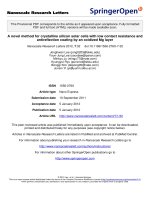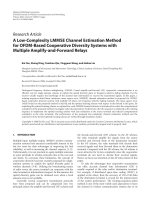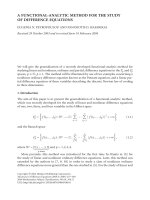Method for removing motion artifacts from fNIRS data using ICA and an acceleration sensor
Bạn đang xem bản rút gọn của tài liệu. Xem và tải ngay bản đầy đủ của tài liệu tại đây (1.4 MB, 4 trang )
35th Annual International Conference of the IEEE EMBS
Osaka, Japan, 3 - 7 July, 2013
Method for Removing Motion Artifacts from fNIRS Data using ICA
and an Acceleration Sensor
Tomoyuki Hiroyasu1 , Yuka Nakamura2 and Hisatake Yokouchi3
Abstract— Independent component analysis (ICA) is one of
the most preferred methods for removing motion artifacts
from functional near-infrared spectroscopy (fNIRS) data. In
this method, fNIRS signal is separated into some components
by ICA. The component which has high correlation between
fNIRS signal and motion artifact is determined. This component
is removed and fNIRS signal without motion artifact effect
is derived. However, because of the influence of blood flow,
fNIRS data are often delayed in time compared with the
acceleration sensor data. Therefore, the correlation is reduced,
and it is difficult to determine whether the component has been
derived from the motion artifact. We here propose a method
for removing the motion artifact using ICA, which considers
the time delay in the fNIRS data. In this proposed method,
ICA is performed multiple times, shifting the start time of the
fNIRS data with each repeat. Then, only the best correlated
result is adopted for comparison with the acceleration sensor
data. To examine the effectiveness of this method, its results
were compared with the results obtained without considering
the time delay. It was found that the proposed method improved
that accuracy of removing the motion artifact.
I. I NTRODUCTION
Functional near-infrared spectroscopy (fNIRS) is a functional brain imaging method, which can measure brain
functions easily, non-invasively, and with relatively few
restrictions[1], [2]. fNIRS is one of the most advanced
medical technologies and has been applied to the diagnosis
of conditions such as depression[3].
fNIRS uses NIRS to measure the changes in blood flow
caused by brain activity, rather than measuring neural activity. Brain activity can be identified by changes in blood
flow because, in most cases, increases in oxyhemoglobin
and decreases in deoxyhemoglobin are observed in activated
areas of the brain[4], [5], [6]. Thus, fNIRS measures brain activity indirectly. However, fNIRS has several disadvantages.
For example, the spatial resolution is low, and deep brain
structures cannot be measured[7]. Changes in blood flow
also occur because of motion artifacts, such as the moving
or bending of the head[8]. Thus, changes in oxyhemoglobin
due to motion artifacts sometimes result in the same patterns
as fNIRS signals produced by brain activity, and changes
in blood flow due to motion artifacts may be mistaken for
brain activity. Therefore, it is necessary to remove the motion
artifact component from the fNIRS data.
1 T. Hiroyasu is with Faculty of Life and Medical Sciences, Doshisha
University
2 Y. Nakamura is with Graduate School of Life and Medical Siences,
Doshisha University
3 H. Yokouchi is with Faculty of Life and Medical Sciences, Doshisha
University
978-1-4577-0216-7/13/$26.00 ©2013 IEEE
Independent component analysis (ICA) is an acknowledged method for removing motion artifacts from fNIRS
data[9]. ICA can identify previously unknown and independent original signals from multiple observation signals.
However, the sources of original signals identified by ICA
are unclear[10], [11]. In this study, to overcome this limitation, we compare fNIRS data with signals obtained using
an acceleration sensor. However, the fNIRS data are often
delayed in time compared with the acceleration sensor data.
Therefore, in this study, we propose a method for removing
the motion artifacts from the fNIRS data using ICA that
considers the time delay, and we examine the effectiveness
of this method.
II. R EMOVING MOTION ARTIFACTS USING ICA
There is a method using ICA for removing motion artifacts
from fNIRS data. However, since it is unclear what has
caused the ICA-separated signal, an acceleration sensor is
used in our proposed method. The ICA-separated signal
is compared with the acceleration sensor data using the
correlation coefficient. This comparison makes it possible to
identify and remove motion artifacts. However, the fNIRS
data are delayed in time compared with the acceleration
sensor data. Therefore, when this method is used on the
fNIRS data, the correlation is reduced, and it is difficult
to determine whether the component has been derived from
the motion artifact. In this report, we propose a method for
removing the motion artifact using ICA, which considers the
time delay in the fNIRS data.
In our proposed method, the measurement is conducted
simultaneously using fNIRS and an acceleration sensor and
is processed as follows:
1) Preprocessing
For preprocessing of ICA, centering and whitening of
the fNIRS data are performed. Through this processing, all components are made mutually orthogonal.
Therefore, the search for the mixing matrix is limited
to the space of the orthogonal matrices. Principal
component analysis (PCA) is used for whitening.
2) Execution of ICA
The fNIRS data are separated by ICA using the FastICA algorithm. This algorithm uses negentropy to
evaluate non-regularity and uses a fixed point algorithm
to search for independent components.
3) Consideration of the time delay in fNIRS data
Firstly, the optimal time delay in fNIRS data must be
found. The small time period is determined and fNIRS
data was shifted with this time period with along
6800
to acceleration sensor data. fNIRS data was divided
into some signals using ICA. Among these signals,
the signal which has the largest value of correlation
coefficient with the acceleration sensor signal is determined. This operation was performed in 100 times
and the average value of the correlation coefficient
is derived. This value is the representative value of
the time period. Then time period is changed and the
same operations were executed. Comparing the average
values of the correlation coefficient of time period, the
time delay which has the largest average value was
determined as the optimal time delay. Secondly, we
executed ICA using fNIRS data that was sifted with the
optimal time delay. The independent original signals
were separated by ICA.
4) Identification and removal of the motion artifact
Since it is not clear what has caused the ICA-separated
signal, the signal is compared with the acceleration
sensor data for identifying the motion artifact[12]. The
acceleration a is compared with the ICA-separated signal. a is calculated from the three-axis acceleration data
using (1). Here, x, y, and z are the axial accelerations
for each direction.
√
a = x2 + y2 + z2
(1)
The correlation coefficient, obtained using (2), is used
for comparison.
¯ (y − y)
¯
∑ni=1 (xi − x)
√ i
rxy = √
¯ 2 ∑ni=1 (yi − y)
¯2
∑ni=1 (xi − x)
(2)
The component that shows the largest correlation coefficient among the separated signals is determined to
be the motion artifact and is removed. The absolute
value of the correlation coefficient is applied because
the plus and minus values of the separated signal may
be reversed.
5) Inverse transformation
The result of ICA from which the motion artifact
has been removed is multiplied by the inverse of
the transformation matrix obtained by ICA. Finally,
this is multiplied by the inverse of the transformation
matrix obtained by PCA in preprocessing. Through this
process, the data are transformed back into the form
of fNIRS data.
compliance with the 10-20 system, the fNIRS probe was
placed in the frontal regions (3x5, 22CH). The sampling
frequency of the acceleration sensor was 10 (Hz), and its
range was ±2 (G). The three-axis acceleration sensor was
fixed on the subject’s head. The subject was a healthy female
(age,22 years, right-handed). The temperature was 23.6 (◦ C)
and the humidity was 49 (%).
The measurement time was 150 (s). During the measurement, the subject watched a cross mark on the screen. For the
first 60 (s), the subject was completely at rest and data were
obtained. For the next 30 (s) or 60-90 (s) after starting the
measurement, the subject moved her head, nodding several
times. She then remained completely at rest for another
30 (s). This cycle of 150 (s) constituted one trial. This
experiment used oxyhemoglobin data that were not processed
by a moving average or filtering. In the fNIRS data, several
large changes in cerebral blood flow were confirmed between
60 (s) and 90 (s) from the start of the measurement, when
the motion artifact was made.
The acceleration waveform is shown in Fig.1. Large
changes in the acceleration can be observed between 60
(s) and 90 (s) from the start of the measurement, when the
motion artifact was made.
The experiment not considering the time delay in the
fNIRS data was performed first. ICA was executed using
data for the 30 (s) period between 60 (s) and 90 (s) from
the start of the measurement, when the motion artifact was
made. 100 trials were executed, since signals separated from
the data vary from time to time. The experiment considering
the time delay in the fNIRS data was then performed with
the same data.
B. Results
The results obtained without considering the time delay
are shown below. Figure 2 shows the ICA-separated signals,
and Fig. 3 shows the fNIRS data before and after removing
the motion artifact. Nineteen separated signals were obtained.
The separated signal with the largest correlation coefficient
value is shown in Fig. 2 by a thick frame. The largest
correlation coefficient value was -0.35. In that signal, the
large changes in cerebral blood flow due to the motion
artifact were confirmed, even after removing the motion
artifact.
III. E XPERIMENT ON TIME DELAY IN F NIRS DATA
This experiment examined the effectiveness of our proposed method by comparing the results of two methods for
removing motion artifacts from the fNIRS data using ICA:
one method that did not consider the time delay and our
proposed method that considered the time delay.
A. Environment and methods
Measurements were performed using fNIRS (ETG-7100;
Hitachi Medical Corporation) and a three-axis acceleration
sensor. The sampling frequency of fNIRS was 10 (Hz). In
6801
Fig. 1.
Variation in acceleration
Fig. 3.
Fig. 2.
fNIRS data before and after removing the motion artifact without considering the time delay
ICA-separated signals without considering the time delay
Fig. 5.
ICA-separated signals with a time delay of 3.2 (s)
value is shown in Fig. 5 by the thick frame. The largest
correlation coefficient value was 0.88. It can be observed
that after removing the motion artifact, the large changes
in cerebral blood flow due to the motion artifact had been
removed from the signal. In addition, Fig. 7 shows a portion
of the fNIRS data between 60 (s) and 90 (s) processed by
fast Fourier transform (FFT) before and after removing the
motion artifact.
C. Discussion
Fig. 4. The relationship between the correlation coefficient and the time
delay in fNIRS data
Figure 4 shows the relationship between the correlation
coefficient and the time delay in the fNIRS data. In Fig. 4,
the correlation coefficient of the fNIRS data with the time
delay of 3.2 (s) is larger than that of the fNIRS data with no
time delay.
The results that considered the time delay are shown
below. Figure 5 shows the ICA-separated signals, and Fig.
6 shows the fNIRS data before and after removing the
motion artifact. Seventeen separated signals were obtained.
The separated signal with the largest correlation coefficient
When the time delay was not considered, the signal that
appeared to be derived from the motion artifact was not
separated. Therefore, it was considered that the correlation
coefficient was small and that the motion artifact had not
been removed. Next, we focused on the other trial, in
which the signal that appeared to be the motion artifact
was separated. However, although the component appeared
to be the motion artifact, the correlation coefficient of the
component was small. Therefore, this component was not
selected, and it was not removed as the motion artifact. Thus,
we considered that it was necessary to shift the start time
of the fNIRS data when applying this method to ICA. The
accuracy of removing the motion artifact was improved by
identifying and considering the optimal time delay.
6802
Fig. 6.
fNIRS data before and after removing the motion artifact with a time delay of 3.2 (s)
In Fig. 4, the optimal time delay was 3.2 (s). In previous
research, the time, according to the hemodynamic changes
in neural activity, was considered to be approximately 5
(s)[13]. Therefore, the 3.2 (s) delay can be considered the
gap between the point where the neural activity occurred
and the point where the change in cerebral blood flow could
be identified.
The correlation coefficient was large when considering
the time delay. In addition, the motion artifact was selected
and removed by visual observation. In Fig. 6, it can be
seen that the effect of the large change in cerebral blood
flow due to the motion artifact was reduced after removing
the motion artifact. Furthermore, in Fig. 7, it can be seen
that the noise component was reduced from 0 (Hz) to 1
(Hz) when considering the time delay. Thus, the accuracy
of removing the motion artifact is improved when the time
delay is considered.
IV. C ONCLUSION
In this report, we explain the necessity of removing the
motion artifact from fNIRS data. We have proposed a method
for using ICA and taking into account the time delay in the
fNIRS data to remove the motion artifact. In this proposed
method, ICA is performed multiple times, shifting the start
time of the fNIRS data. Then, only the best correlated result
is adopted for comparison with the acceleration sensor data.
The results obtained with the proposed method were also
compared with those obtained with traditional ICA, which
does not consider the time delay. The effect of the large
changes in cerebral blood flow caused by the motion artifact
was reduced significantly when considering the time delay.
In conclusion, the accuracy of removing the motion artifact
is improved using our proposed method, which considers the
time delay of the fNIRS data.
R EFERENCES
[1] X. Cuia, S. Braya, D. M. Bryant, G. H. Gloverc, and A. L. Reiss,
“A quantitative comparison of nirs and fmri across multiple cognitive
tasks,” NeuroImage, vol. 54, no. 4, pp. 2808–2821, 2011.
Fig. 7.
One example of the result of FFT
[2] J. S. Soul and A. J. Plessis, “Near-infrared spectroscopy,” Seminars in
Pediatric Neurology, vol. 6, no. 2, pp. 101–110, 1999.
[3] K. Matsuo, T. Kato, M. Fukuda, and N. Kato, “Alteration of
hemoglobin oxygenation in the frontal region in elderly depressed
patients as measured by nearinfrared spectroscopy,” The Journal of
Neuropsychiatry and Clinical Neurosciences, vol. 12, no. 4, pp. 465–
471, 2000.
[4] A. Villringer, J. Planck, C. Hock, L. Schleinkofer, and U. Dirnagl,
“Near infrared spectroscopy (nirs): a new tool to study hemodynamic
changes during activation of brain function in human adults,” Neuroscience Letters, vol. 154, no. 1-2, pp. 101–104, 1993.
[5] K. Sakatani, E. Okada, S. Hoshi, and I. Miyai, NIRS Basic and
Clinical(in Japanese). Shinkoh-igaku, 2012.
[6] Y. Hoshi and M. Tamura, “Detection of dynamic changes in cerebral
oxygenation coupled to neuronal function during mental work in man,”
Neurosci. Lett, vol. 150, pp. 5–8, 1993.
[7] M. Fukuda, Mental illness and NIRS(in Japanese).
Nakayama
bookstore, 2009.
[8] K. Takeda, M. Watanabe, Y. Gunji, and H. Katou, “Effects of head tilt
to near-infrared sepctroscopy(in japanese),” Journal of Rehabilitation
Neuroscience, vol. 8, pp. 21–24, 2008.
[9] F. C. Robertson and E. M. Meintjes, “Motion artifact removal for
functional near infrared spectroscopy:a comparison of methods,” IEEE
Transactions Biomedical Engineering, vol. 57, no. 6, pp. 1377–1387,
2010.
[10] A. Hyvarinen, J. Karhunen, and E. Oja, Independent Component
Analysis. John Wiley & Sons, 2004.
[11] A. Hyvarinen and E. Oja, “Independent component analysis: algorithms and applications,” Neural networks : the official journal of the
International Neural Network Society, vol. 13, no. 4, pp. 411–430,
2000.
[12] k. Koga, Y. Katayama, and K. Iramina, “The relationship between nirs
and acceleration running a head tilt,” MAG, no. 167, pp. 7–9, 2010.
[13] D. Sato and A. Maki, “Functional brain imaging by light : Optical
topography(in japanese),” Cognitive Studies, vol. 12, no. 3, pp. 296–
307, 2005.
6803


![Standard Test Method for Compressive Strength of Hydraulic Cement Mortars (Using 2-in. or [50-mm] Cube Specimens)](https://media.store123doc.com/images/document/14/rc/yi/medium_yil1395845738.jpg)






